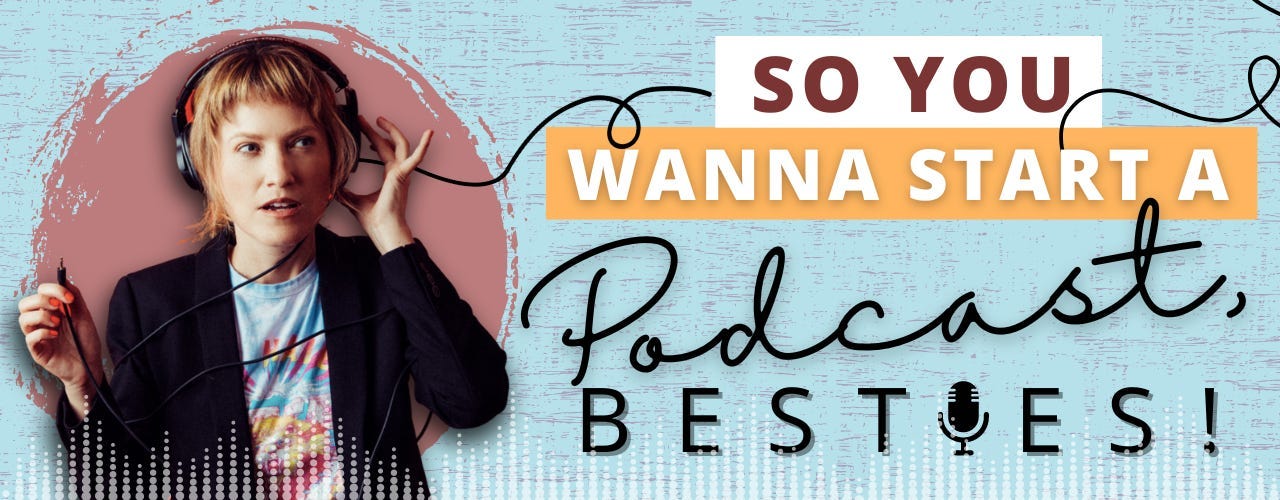So You Wanna Start a Podcast 🎙
20 simple (but not easy) steps to launch your own show
Hey Besties!
This issue was inspired by two recent podcasting classes I taught—so many great questions (and mental blocks) came up that I decided it was time to update and re-share this guide. Podcasting has evolved, but the fundamentals haven’t changed: it’s still one of the best ways to expand your creative reach, build community, and open new career doors.
If you’ve been podcast-curious, this is your sign to start. And if you want more guidance and accountability, I have one final four-week podcasting class coming up starting this Sunday, November 2 via WritingWorkshops.com. It’ll be my final podcasting course for a while because I need to focus on promoting my book. So if you want a structured sandbox to finally get your show up and running, get in on the fun while you can!
From starting my first podcast in 2013 to producing shows for celebrities and CEOs, I’ve learned a lot. I’ve learned to treat my podcast like a business; these days, it’s actively generating client leads and sponsorships. Not to mention, it’s grown my personal and professional network and enhanced my résumé, reputation, and sphere of influence. (Okay, slow down, Napoleon, lol.)
Podcasting has been a transformative force in my life, and it’s the cornerstone of my creative career. Podcasting has changed the game for me.
✨ It’s changed my ability as a storyteller.
✨ It’s changed my knowledge base.
✨ It’s changed my network and relationships.
✨ It’s changed my mindset.
✨ It’s changed everything.
And now, it’s my mission to help my Besties reach their goals through podcasting. Starting a podcast isn’t easy, but it can be so rewarding. Here’s my updated advice on how to begin:
1. Start with your “why”
Your why is your foundation. Ask yourself:
Why this podcast, and why now?
What gap or need are you filling?
What do you want it to do for your creative life or career?
Your reason can be big or small, personal or professional—but it has to matter enough to keep you going when motivation dips.
2. Set a clear goal
What does success look like for you?
Ask yourself honestly, “What do I want to accomplish with this podcast?”
✓ Generate X more leads for my business per month
✓ Make a handful of high-level contacts in my industry this year
✓ Establish myself as a thought leader and land speaking gigs
✓ Help listeners solve Y problem
✓ Tell an important story my community should hear
Your short-term goal should be specific, measurable, and attainable—like to launch a six-episode season. Your long-term goal can be aspirational (land sponsors, grow to 100K monthly downloads, adapt the show into another medium, interview your hero, etc.).
3. Nail your concept
Okay, you know why you want to make a podcast, so now it’s time to decide what your show is. Solo? Interview? Narrative? Hybrid?
Pick what fits your strengths and goals.
Solo: build authority and intimacy
Interview: expand your network
Narrative: sharpen and show off storytelling skills
Concept = Format + Genre + Niche
Examples:
A 10-minute solocast of ASMR mindset pep talks.
A 30-minute interview-style business show with CEOs sharing their biggest failures.
A 45-minute narrative nonfiction show featuring old Hollywood true crime stories from a feminist POV.
4. Define your audience
Now that you know what the podcast is, ask: “Who do I want listening, and what should they get out of it?”
Visualize your ideal listener:
Age, vibe, values, and frustrations
What they care about
Where they hang out online
Maybe you’re trying to reach career-driven new moms struggling with work-life balance. Or techies who want to stay up-to-date on the latest advancements. Clarity here makes everything easier—from picking topics to promotion. Try to serve your listener first, always.
5. Write a mission statement
Synthesize your goal, concept, and audience into one guiding sentence.
Are you trying to entertain, educate, destigmatize, or shed light on an overlooked issue? This is your show’s purpose.
You don’t have to post your mission statement anywhere if you don’t want to. It’s just for when you’re like, “wait, why am I doing this again?” It’ll also help you determine which collaborations and monetization opportunities are aligned down the road.
Private Parts Unknown: destigmatize conversations about sex and relationships.
The Bleeders: demystify the book writing and publishing process for emerging authors.
Your mission = your North Star.
6. Choose a title that works
Pick something clear and memorable. Clever is fine, but clarity wins. Not everyone has to “get it,” but your target audience does.
Another important thing to consider: SEO. If your show’s about marketing or motherhood, consider including that keyword.
Double-check your title on Apple Podcasts and Spotify before finalizing to make sure another active podcast isn’t using it.
➡️ Podnews editor James Cridland offered some advice on naming your podcast in his Podcast Bestie Q&A:
7. Craft a catchy tagline
Distill your vision into a one-liner that tells listeners what they’re getting. It should be easy to grasp and remember.
Private Parts Unknown: “a podcast about love and sexuality around the world.”
The Bleeders: “a podcast (and support group!) about book writing and publishing.”
Use it in your intro and description, as well as marketing and promo materials for consistent branding.
8. Pick a sustainable cadence
Say it with me: NOT 👏 EVERY 👏 PODCAST 👏 NEEDS 👏 TO 👏 BE 👏 A 👏 WEEKLY 👏 PODCAST. 👏
Start small. A six-episode season allows you to learn and iterate without burnout. Listeners will forgive breaks; they won’t forgive ghosting. Consider the best fit for the concept AND what’s sustainable for you.
9. Plan your first season
Outline your episodes—topics, guests, and segments. Keep a content calendar (I use Google Sheets for mine).
Set a premiere date and work backward. How much lead time do you need to comfortably prepare for your launch and have at least a few episodes in the can? (Preferably the whole season.) Having that deadline will keep you accountable.
10. Do market research (aka comps are your friend)
Find 2–3 comparable shows. Note their tone, episode length, and release schedule.
Ask: Where does my show fit—and how will it stand out?
This helps carve out your lane before you hit record. Really listening to any podcast can provide inspiration. I recommend exploring lots of different shows at this phase…
Don’t over-research, though. Inspiration = good. Analysis paralysis = bad.
11. Gear up
You do not need a fancy studio or expensive equipment to get started.
Starter setup:
🎙 Mic: At the absolute most, start with a Shure MV6. I love this mic, but you can also just get any $50 USB mic to start.
🎧 Headphones: closed-back, wired—my professional headphones hurt my ears, so I just use a pair I got for free on an airplane.
💻 Software: Descript (all-in-one recording + editing)
Don’t overinvest early; grow with your show.
12. Record smart
Even with AI, you can’t always “fix it in post.” Instead, avoid bad audio in the first place. Here’s how:
Record in a quiet, soft-furnished space (avoid kitchens, bathrooms, and vaulted ceilings).
Face away from hard surfaces (walls, windows) when possible.
Keep the mic ~3–6 inches from your mouth. Test your levels beforehand!
Always wear headphones to prevent echo.
Always get a backup track. QuickTime or the Voice Memos app on a phone are good options that almost everyone has access to.
Good audio ups your credibility.
13. Edit well
Editing is where the magic happens—a thorough pass can elevate your content.
Checklist:
✓ Remove filler words (“um,” “like”)
✓ Trim tangents and long pauses
✓ Balance volume
✓ Add intro/outro music
✓ Export 128–192 kbps
14. Logo
Simple yet striking is a good rule of thumb for podcast logos. For inspiration, look through your podcast player and see what catches your eye. Create your own with Canva or hire a designer (99designs is an option).
15. Produce a trailer
Your trailer is your first impression. Keep it to an intriguing 60–90 seconds.
Hook → Introduce → Invite
End with: “Follow wherever you listen and tune in on [date].”
16. Choose a host (Substack is a smart start)
If you’re new, start on Substack.
It’s free.
It has a built-in newsletter and growth tools.
You can upload audio posts with zero RSS setup, which lets you test ideas and find your voice before launching your first season.
When you’re ready for advanced analytics and ads, migrate to Captivate and keep your stats intact.
17. Build your launch plan
Give yourself at least a month to prepare:
Announce your show and logo
A week later, drop a teaser to activate your feed
A week later, release your trailer
A week later, launch your first episode
Use Substack to share behind-the-scenes updates and build anticipation.
18. Promote every episode (again and again)
Post on launch day, two days later, and again next week. Use different angles each time: quote, clip, question, or behind-the-scenes photo.
People need to see something multiple times before they act.
You don’t have to be everywhere—just pick your lanes and stay consistent.
Options to try:
Expand episodes into Substack articles (I love doing this for The Bleeders)
Share clips or audiograms on Reels and/or TikToks
Post on Threads or LinkedIn if that’s your crowd
Do guest swaps or promo trades (Tink Media has a great database for finding collaborators)
Promote with the same enthusiasm you bring to the mic.
19. Rinse & repeat
Repeat the relevant steps to sustain your podcast. Keep refining. Avoid the perfectionist trap, but raise your quality as your skills grow.
You learn by producing and publishing, so keep creating and shipping.
Remember Ira Glass’s advice: your taste is killer—but your early work won’t match it yet. The only way to close the gap is through volume.
Your voice will strengthen. Your workflow will tighten. Your audience will find you.
Just keep going.
20. Don’t overthink it—just start ✨
Podcasting has opened so many doors for me: creative, financial, and personal. It’s given me community, confidence, and a platform to share stories I care about.
But none of that would have happened if I hadn’t taken the first step.
If you’ve been hesitating, take messy action today.
And if you want hands-on support, join me for my final live class for a while on November 2. It’s the perfect container to turn your idea into a launch-ready show.
Who knows—your little podcast idea might just change your life.
So… ROLL CALL! 🗣
For those who have been podcasting for a while, what’s YOUR best advice for new podcasters? Aspiring podcasters, do you have any further questions?





Hi I love all this advice. I started Our Plant Stories 3 years ago, just finishing my 3 series. I love audio and plants so it enables me to follow two passions! My advice would be follow your passion and be curious. If you are curious about your subject, you will find stories and stories will find you. Sally